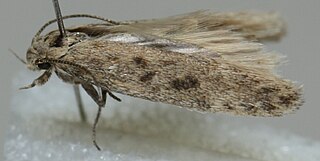Eulamprotes helotella is a moth of the family Gelechiidae. It is found in Spain, Portugal, France, Italy, Greece, Corsica, Sardinia, and Crete. It is also found in North Africa.

Scrobipalpa obsoletella, the summer groundling, is a moth of the family Gelechiidae. It is found in most of Europe, Turkey, the Caucasus, from Iran to Asian Russia (Transbaikal) and Mongolia. It has also been recorded from New Zealand, South Africa and North America, where it is probably an introduced species. The habitat consists of coastal salt marshes and sandy beaches.
Dichomeris acrolychna is a moth in the family Gelechiidae. It was described by Edward Meyrick in 1922. It is found in Pará, Brazil. The wingspan is 9–11 mm (0.35–0.43 in). The forewings are rather dark ashy fuscous, obscurely whitish speckled. The stigmata are dark fuscous or ferruginous brown, the plical somewhat beyond the first discal. There is a curved dark ferruginous-brown subterminal shade sometimes perceptible. The hindwings are dark grey.
Hypatima euplecta is a species of moth in the family Gelechiidae. It was described by Edward Meyrick in 1904. It is found in Australia, where it has been recorded from Queensland, New South Wales, Victoria and South Australia.
Filatima vaniae is a moth of the family Gelechiidae. It is found in North America, where it has been recorded from Utah and California.
Filatima sperryi is a moth of the family Gelechiidae. It is found in North America, where it has been recorded from California, Nevada and Utah.
Filatima procedes is a moth of the family Gelechiidae. It is found in North America, where it has been recorded from Indiana, Michigan and Texas.
Filatima catacrossa is a moth of the family Gelechiidae. It is found in North America, where it has been recorded from Texas and Arizona.
Filatima normifera is a moth of the family Gelechiidae. It is found in North America, where it has been recorded from Texas and Wyoming.
Filatima collinearis is a moth of the family Gelechiidae. It is found in North America, where it has been recorded from Texas.
Filatima gomphopis is a moth of the family Gelechiidae. It is found in North America, where it has been recorded from Texas.
Filatima inquilinella is a moth of the family Gelechiidae. It is found in North America, where it has been recorded from New York and Maine.
Filatima fuliginea is a moth of the family Gelechiidae. It is found in North America, where it has been recorded from Texas.
Filatima nucifer is a moth of the family Gelechiidae. It is found in Mexico (Sonora) and the United States, where it has been recorded from Texas.
Filatima pravinominella is a moth of the family Gelechiidae. It is found in North America, where it has been recorded from Colorado.
Filatima saliciphaga is a moth of the family Gelechiidae. It is found in North America, where it has been recorded from California.

Filatima serotinella is a moth of the family Gelechiidae. It is found in North America, where it has been recorded from Alabama, Alberta, Arkansas, Colorado, Illinois, Indiana, Kansas, Kentucky, Louisiana, Maine, Maryland, Mississippi, South Carolina, Tennessee, Texas and West Virginia.
Filatima striatella is a moth of the family Gelechiidae. It is found in North America, where it has been recorded from Alberta, Texas and Arizona.
Filatima tephrinopa is a moth of the family Gelechiidae. It is found in North America, where it has been recorded from Texas.

Ichneutica paracausta is a moth of the family Noctuidae. This species is endemic to New Zealand. It is found locally in the central North Island, is widespread in the South Island and can also be found in Stewart Island. I. paracausta is variable in colour, but as it has a distinctive black streak on its forewing as well as a wing pattern that is characteristic, I. paracausta is unlikely to be confused with other species. It is present on the North Island volcanic plateau as well as Little Bush Reserve in Hawkes Bay in the North Island as well as in tussock grassland, alpine and subalpine shrubland and in alpine forest. Larvae have been recorded as feeding on grasses, a pupa has been found in a cocoon under the bark of a tree and adult moths are on the wing from October to January.


